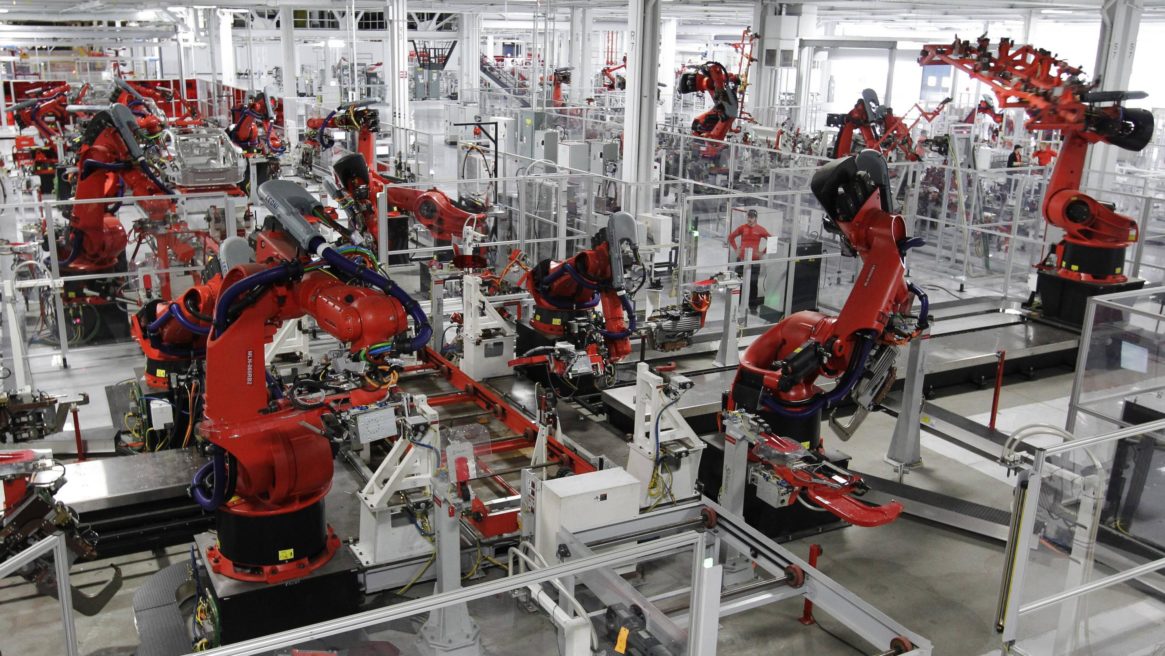On the implications of intelligent machines and the transition to the knowledge economy.
INTRODUCTION
Knowledge has become currency in the global economy. The knowledge economy is elevating Information as the primary source of value, overtaking material resources from our Industrial past. This is because Information feeds and defines intelligent machines.1 And it’s these intelligent technologies that leverage human knowledge, which help us to achieve more.
So, as human knowledge is supplemented by intelligent machines, more humans are becoming a function of their ability to interact with intelligent machines. Therefore, equipping people with technical skills is of growing importance.
Particularly important are the technical skills that enable people to build, manage, and improve the software and hardware powering intelligent machines. This includes skills such as design engineering, software development, and robotics. But it equally extends to areas such as Data Analysis, Human-Computer Interaction, or other technical disciplines helping steer intelligent technologies. Ultimately, it’s technical skillsets such as these that enhance human knowledge and help unlock idle capacity.
However, these technical disciplines demand high levels of skill. They require training and preparation, often with a strong foundation in Science, Technology, Engineering and Mathematics (STEM). As the demand for high-skilled labour outpaces lower-skilled work,2 industry is unable to meet these demands because people aren’t upskilling fast enough. This is concerning because low and medium-skilled jobs are at the greatest risk of automation.3
There are two central problems underlying these labour market dynamics:
- The majority of the world’s labour force are low and medium-skilled workers, with a disproportionate amount of whom live in the Global South4;
- Not nearly enough is being done to upskill and prepare workers for the demands of the knowledge economy, particularly in the Global South.
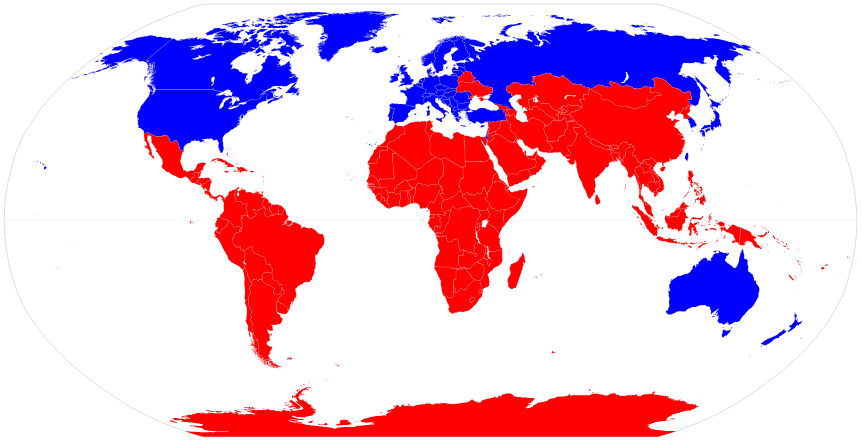
Map of the Global South in red and Global North in blue
Source: Wikimedia Foundation
The implications of widespread skill shortages are significant. Income inequality will rise; social unrest will ensue; and entire populations could lose their opportunity to contribute. While this dystopian outlook is intentionally hyperbolic, there are signs that this is already happening.5
It doesn’t have to be this way. This doesn’t have to be our future.
Through systematic education and training we can raise the hidden talents and untapped potential of current and future workers. However, it will require a different conception of how skills are developed and education is delivered. We’ll need a strategy that follows a demand-led approach, which engages industry as central partners in the design and delivery of skills education. A movement away from the tired education model of ‘credentialing’, and a reorientation towards in-demand skill acquisition. Governments and International Institutions are central to helping facilitate these solutions.
A core focus needs to be placed upon the development of greater technical skills. This will enable people to build, manage, and interact with intelligent machines in the workforce. Equally important are the social and interpersonal skills that are the basis of human cooperation and the ability to navigate quickly changing labour markets. These are the broad skillsets that are in demand now and in the future. More specifically, Governments and Educational Institutions would do well to emphasise and develop the following three main skill areas:
-
- Software Development, by equipping people with the skills to build and manage software applications;
- Design Engineering, by learning to design, improve, and build objects through disciplines such as Robotics, 3D printing, and Mechatronics;
- Work readiness, by training and mentoring people to navigate modern labour markets, pursue in-demand education, or start their own businesses.
This alone is not the answer, but building creative responses around these skill development areas should be part of the solution. Building an inclusive future takes work. To leverage intelligent machines that harness the full power of human creativity requires careful planning, technical skills, and a deliberate view of the future.
THIS IS A BIG DEAL
As intelligent technologies intersect with more parts of our lives, it’s changing how we live and how we work, regardless of geography. It’s shifting the primary sources of value from material assets to knowledge. This transition is most obviously seen in the stock market. In 1997, technology companies made up 2 out of the top 10 companies by market capitalisation; fast forward 20 years, it’s jumped to 5 out of 10.
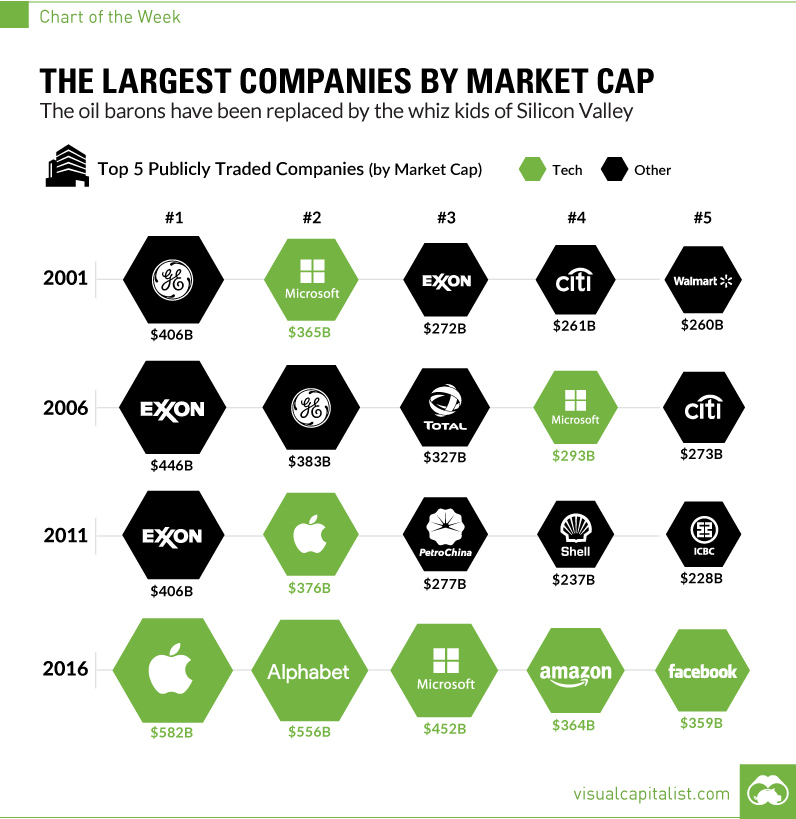
Source: Visual Capitalist, August 2016
This is significant because economic value is an indication of social authority. It represents the growing role that technology plays in our lives. And it highlights the greater authority we grant technology to inform our social dynamics.
When we need to travel from one place to another, we seldom ask a friend or close passerby for detailed directions. Instead, we pull out our smart phones and ask Google Maps. For countless routine tasks, we’ve elevated intelligent machines as the higher source of authority over people. Google knows best.
The ability of intelligent machines to complete cognitive tasks is revolutionary. Cognitive tasks have historically been reserved to human labour; now they’re routinely performed by machines at breakneck speeds.
Amazon’s book recommendations is a familiar example of an intelligent machine. While browsing, Amazon recommends books based on information like your purchase history, search history, and user profile, with the goal of selling more books. Your recommendations adapt as new information is provided by you and others. The more information Amazon collects, the more accurate their recommendations become, the higher their book sales rise. The wise local bookstore owner doesn’t stand a chance.
All of this speaks to the higher value we’re placing on knowledge. We see this in the growing market value of technology firms, the rapid wage growth of software developers,6 and the average 10 hours per day7 we spend on internet connected devices. All of these indicators show that we’ve entered the ‘Information Age’. And information is transferred through applied technologies that feeds ‘knowledge’ in the knowledge economy.
THE IMPORTANCES OF CONTRIBUTION
Equipping people with technical skills is important for two main reasons:
- Personal contributions – This applies to both economic and social contributions. Acquiring the technical skills of a software developer places an individual in high demand. They’re able to attract a higher salary, which can help improve the well-being of themselves and their family. Less measurable, but no less significant, are the well-being and identity benefits that arise from contributing to important work. This isn’t to say that all important work is reserved to people with technical skills. They’re not. But as technology is increasingly applied to help solve our most pressing problems, like climate change, healthcare, and education, a strong technical skillset is often required to be part of these solutions. This requirement for technical skills to help solve hard problems will continue to increase.
- Collective contributions – The degree of change instigated by technology should not be dismissed by the magnitude of what’s left to do. While Twitter may feel like a passing fad, it’s still global instant communication, for free. That’s a significant social advancement. What’s even more significant is how small the group of people behind these changes are. They’re a tiny proportion of the world’s population, with highly technical skills. So, imagine what we could collectively achieve if we broadened the talent pool, even just a little. A rising tide lifts all boats.
The point is, enabling people to meaningfully contribute in a future with more intelligent technologies is good for the individual and the collective.
THE TIME IS RIPE
All signs point to a future where intelligent technologies intersect with more parts of our lives. This greater role will largely be made possible by progress in Artificial Intelligence (AI).8 We’ve seen false starts and similarly large claims about AI before,9 but we’re on the precipice of something big.
The breakneck advancements in AI are being brought about through a confluence of developments. The driving factors are:
- Greater computational power
-
-
- Moore’s Law has largely held constant since 1971, with CPU transistor counts doubling every two years. The same applies for quality adjusted microprocessor prices, memory capacity, sensors, and pixels in digital cameras.10
-
- Increased quantities and access to training data
-
-
- The proliferation of devices and applications have exploded, which has caused a 50% compound annual growth rate (CAGR) from 2010.11
-
- Better algorithms
-
-
- The processes and techniques that construct algorithms have become more sophisticated. Algorithm methods such as convolutional, feedforward, and adversarial networks are improving large-scale data processing.
-
- Broad investment
-
-
- Growth in private AI investment has increased by 6X between 2011 to the beginning of 2016 alone.12
-
- Open source frameworks and libraries
-
- The open sourcing of AI tools such as Google’s Tensor Flow, Facebook’s Torch, and Amazon’s DSSTNE have made it more accessible than ever for companies and individuals to apply their data to some of the most powerful AI technologies.
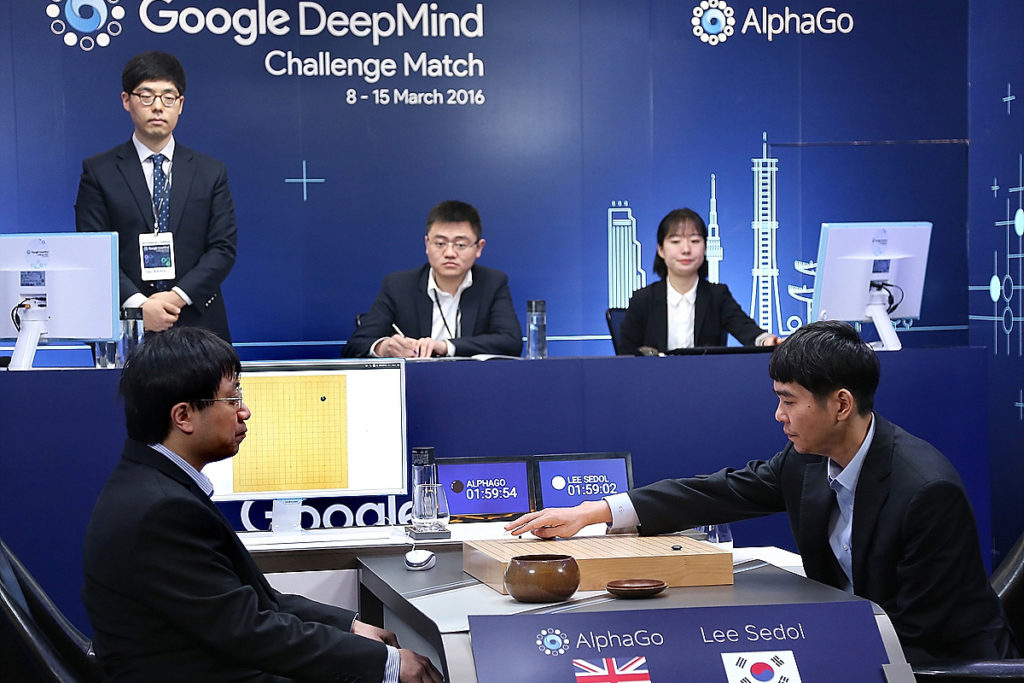
AlphaGo plays Lee Sedol in 2016
Source: New Scientist, 4 January 2017
These advancements are driving the progress of intelligent machines. As they continue to develop, they will increasingly intersect with more parts of our lives, including work.
1984 OR UTOPIA?
Too often, the impact of AI on the future of work is debated from two extreme ends of the spectrum. On one side, the Dystopians anticipate humanity’s obsolescence; on the other, the Utopians predict Heaven on Earth.
Both make headlines. Both Brave New Worlds with more AI. Neither are particularly helpful.
While these predictions are still possibilities that shouldn’t be ruled out, they offer little explanation with how we get there. More helpful is a view of history, rooted in the present.
Let’s consider the effects of the Industrial Revolution on employment. The labour market has historically been split into three main sectors: agriculture, industry, and services. Until around 1800, the majority of Americans were employed in the agricultural sector. Just one century later, the employment rate in agriculture had halved. Significant portions of agricultural labour were automated, people moved to urban centres for industry-based jobs, and as education improved, a growing populace took up service professions. By 1900, the three sectors were almost evenly distributed.13 This was a seismic shift from the fields and herds, to the cities and factories.
And the pace of change continued to accelerate. By 2010, only 2 percent of Americans were employed in agriculture, 20 percent in industry, and the 78 percent majority assumed service-based employment.14
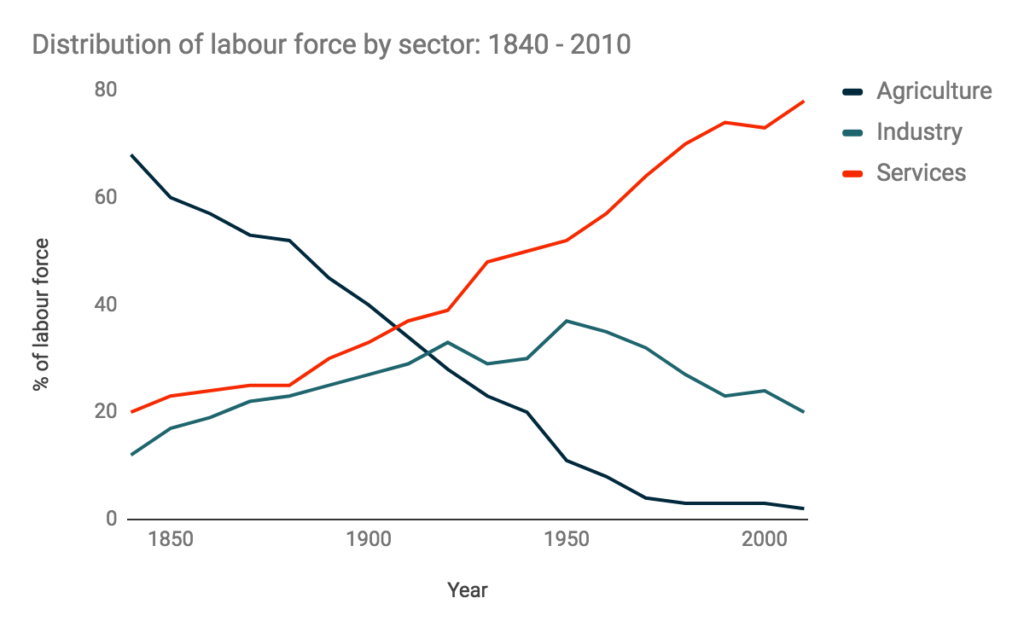
Source: Lewis Johnston, MinnPost15
So, how do the changes of the Industrial Revolution help inform the transition we’re experiencing with the Information Revolution?
There are similarities and differences. The similarities revolve around the human response and public perception to these changes; the differences concern the fundamental technologies driving these changes and their effects.
THE PROMETHEAN MYTH
The awakening of the Industrial Revolution evoked fears of mass-unemployment through mechanical automation. People worried about the obsolescence of humanity and the Luddites screamed about the unravelling of social order.
This response has been a constant throughout history. It goes as far back to Greek Mythology with the ‘Promethean Myth’: Man acquires fire from the Gods; fire becomes the source of Man’s pain and suffering. We hear variations of the same narrative today: humans build and deploy robots; robots take our jobs and our purpose.
Yet, the fears of the Promethean Myth have been consistently unfounded. To take the position that ‘this time is different’ is a complete abnegation of economic history.
Of course new jobs will be created. Ideas, industries, and fields will be conceived that we haven’t even imagined. The economic process of ‘Creative Destruction’ will upend markets, replacing jobs from the ‘old’ economy and ushering in the ‘new’.
A 2011 study by McKinsey found that the Internet had destroyed 500,000 jobs in France in the previous 15 years. However, over the same period, the Internet had created 1.2 million jobs. That’s a net employment addition of 700,000 and a rate of 2.4 jobs created for every job destroyed.16
This has been a constant occurrence across generations. We’ve seen technology over the past 144 years create more jobs than it’s destroyed.17 And it continues to do so, with the net rate of job creation increasing over the past two decades.18
This isn’t wishful thinking or wilful ignorance; it’s pragmatic reasoning centred around the history and potential of human creativity.
So what’s all the fuss about?
IT’S ALL ABOUT SKILLS
If we project that the trend of ‘job replacement’ by new technologies will continue, then the next step is to consider what types of jobs will be demanded.
This is where we begin to approach unfamiliar territory.
The transition from the Agricultural Revolution to the Industrial Revolution saw entire populations move from farmlands to factories. This transition, however, was still predominantly a movement between low-skilled vocations.19 People shifted from the physical labour of toiling the earth to joining the assembly line of a steel mill. Very different work, but still low-skilled jobs to low-skilled jobs.
The fundamental difference with the transition to the Information Age is the greater demand for high-skilled labour. This demand is driven by the growing proliferation of intelligent machines. And the ability to interact with these intelligent machines requires strong technical skills.
The core problem is that people aren’t developing these skills at a sufficient pace.
More jobs today require higher levels of preparation and this rate is increasing. According to the US Department of Labor, American workers requiring above-average skills increased by 68% from 1980 to 2015. This is more than double the demand for workers with below-average skills, which only increased by 31% over the same period.20
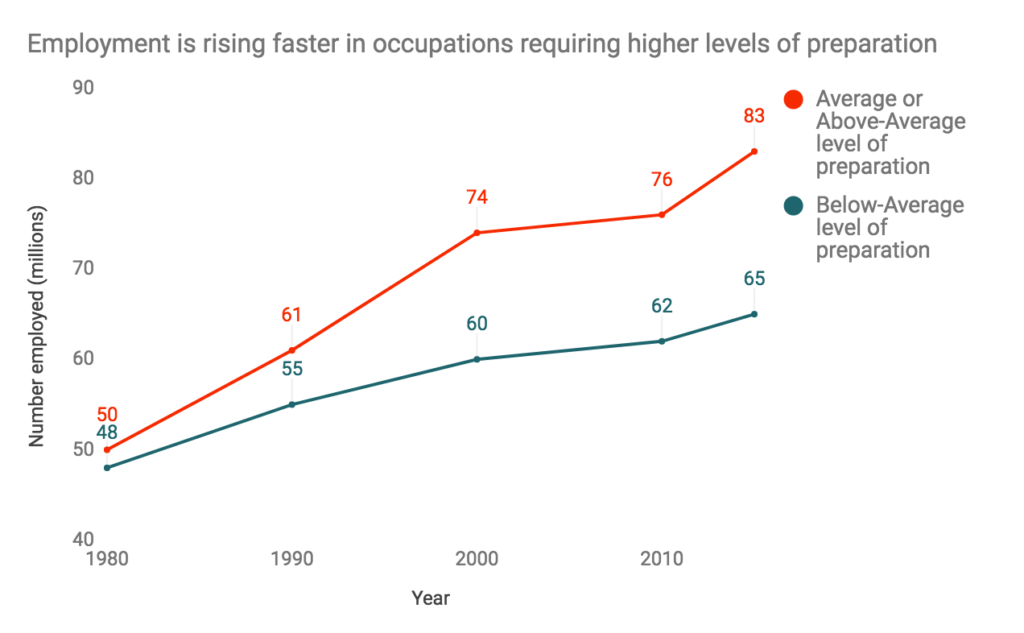
Note: based on employed US citizens aged 16 years and older.
Source: Pew Research Center21
This growth in demand for workers with higher levels of preparation is a function of the higher levels of skillsets demanded for these jobs. The modern economy is disproportionately demanding and valuing advanced cognitive skills.
Occupations requiring higher levels of social or analytical skills grew significantly between 1980 to 2015. Jobs with above-average social skills, like communications and people management, grew by 83%. Similarly, employment in jobs that require above-average analytical skills, such as non-routine cognitive and highly technical tasks, increased by 77%. This dwarfs the employment growth of labour with higher levels of physical skills, which only grew by 18% over the same period.22
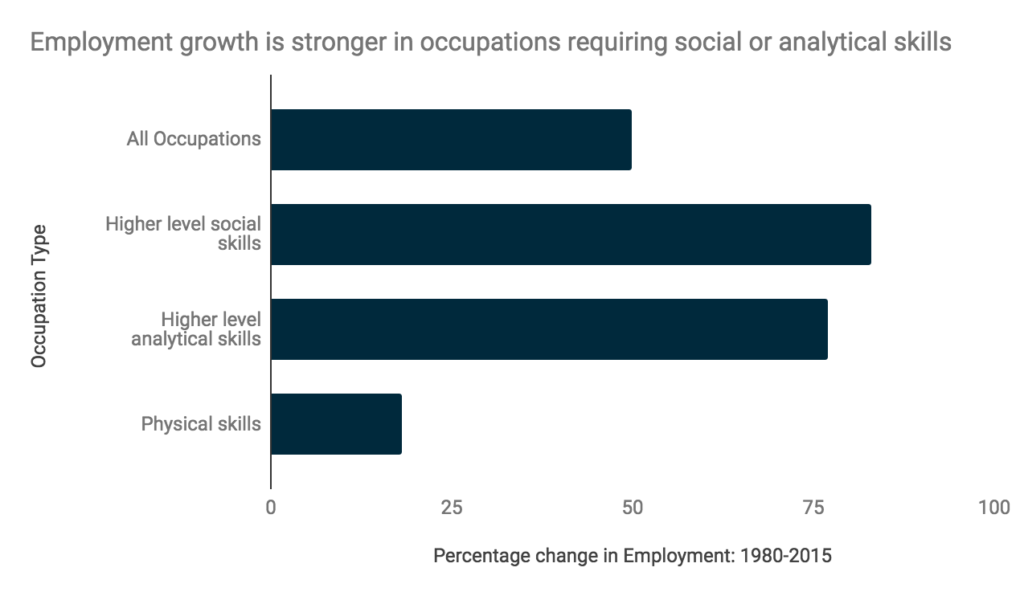
Note: based on employed US citizens aged 16 years and older.
Source: Pew Research Center23
This growing demand for higher levels of preparation and skills is indicative of the transition to the knowledge economy. As physical labour is increasingly automated, the demand for cognitive labour grows, particularly non-routine cognitive labour.
Physical labour and routine manufacturing are being automated because it’s now more efficient for machines to complete these tasks. This is not the case for social and analytical skills aforementioned. It’s extremely difficult for intelligent machines to complete abstract social tasks and non-routine cognitive exercises. Machines can’t yet deal with the social idiosyncrasies of people management, or the analytical rigours of strategy development – at least as effectively as humans. There are certainly intelligent machines that supplement these areas. And it’s crucial for people in these roles to be able to interact with these intelligent machines. However, these machines are applied to what they do best: computation and data processing.
Therefore, the concern shouldn’t be that there won’t be jobs created on the foundations of AI; the concern should be that we won’t have enough people with the skills to do these jobs.
SKILL SHORTAGES AND THEIR DISCONTENTS
The implications of skill shortages result in unfavourable economic and social outcomes. The mismatch between the growth rates of rising high-skilled labour demand and sluggish high-skilled labour supply impact us all. It affects us economically, socially, and morally.
If only a small and shrinking proportion of the world’s population can fulfil these high-skilled jobs, it places downward pressure on everyone else. More people enter the pools of lower skilled work and wage rates decrease as more people slide down the skill curve. Meanwhile, wages in higher-skilled labour disproportionately rise.
This growing gap between income advancement and employment opportunities has widened over the past few decades. For instance, US college graduates in 1981 earned a wage premium of 48% over high school graduates. By 2005, the wage premium had risen to 97% – college graduates earn almost double that of high school graduates.24 This growing income inequality is reflected across the world, and felt most acutely in the Global South.
Disparities in wealth and earnings potential have been a constant in capitalist economies. However, automation and the subsequent rising demand for high skilled labour could accelerate this inequality. The White House noted in 2016 that the effects of automation through AI on labour markets will likely grow over the forthcoming decade.25
This means that more jobs, or parts of jobs, will experience automation by intelligent machines. McKinsey Global Institute researched automation potential by examining over 2,000 work activities across 46 countries, which represents around 80% of the global workforce. Their research found that the proportion of occupations that could be fully automated by demonstrated technologies is small – less than 5%. The potential for partial automation, however, is much higher. Around 60% of all occupations have at least 30% of activities that are technically automatable, based on current technologies.26 Therefore, the majority of occupations will change, and more people will have to interact with intelligent technologies as part of their work.
Automation potential based on demonstrated technology of occupation titles in the US (cumulative)
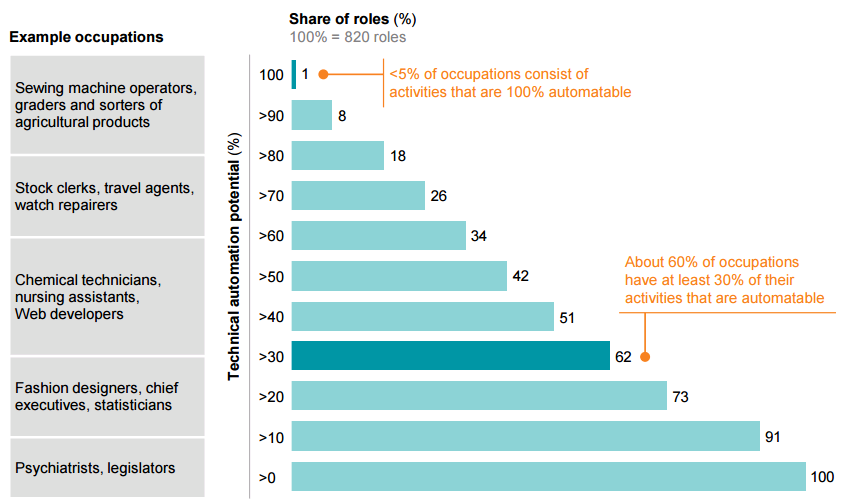
Source: McKinsey Global Institute27
If people fail to sufficiently upskill, this will disproportionately favour the highly skilled. Conversely, it will disfavour the low and medium-skilled workers who are unprepared for the demands of the knowledge economy.
Not only could the labour supply of similarly lower-skilled workers increase, placing downward pressure on wages, but lower skilled and cheaper labour is more likely to come under pressure from automation.
The Council of Economic Advisers to the White House ranked the probability of automation according to wages. They found that 83% of jobs making less than $20 per hour would come under pressure from automation. This is over twenty times more likely than jobs earning $40 per hour.28

Source: Jason Furman29
Regardless of whether these probabilities are exactly accurate, the magnitude of this variance is immense. Assuming that wages are correlated with skill-levels, these projections show that automation could cause a disproportionately large decline in the demand for less-skilled jobs, and a minimal decline in demand for high-skilled jobs. As a result, wage pressures rise and inequality gaps widen.
This has been playing out for decades. Wages as a share of GDP in advanced economies has dropped sharply since the 1970s.30 Yet, wages for the highest income earners over the same period have risen consistently.31 While it’s wrong to attribute this growing inequality as a pure function of technology, people have not acquired the necessary skills at a sufficient rate to meet these emerging labour demands.
All of this speaks to a systematic failure to adequately prepare people for the future of work.
DEVELOPING COUNTRIES WILL BE HARDEST HIT
As the majority of low and medium skilled workers live in developing countries, the developing countries are at the greatest risk.
Cheap labour, improved logistics, and internet connectivity enabled offshoring of manufacturing in advanced economies. This ‘deindustrialisation’ helped lift incomes and living standards in the developing countries that assumed this outsourced labour. It also guided the transition of advanced economies toward more service-based labour (as previously discussed).
Therefore the fundamental concerns for developing economies are the same as advanced economies, they’re just more protracted. The central issue is still the rate of skill acquisition.
At the current rate, the projections look bleak. A World Bank report found that two-thirds of all jobs in the developing world face significant automation.32 Interestingly, the majority of these are likely to be middle-skilled, middle-paying occupations (for e.g. clerks, plant and machine operators). Low-skilled jobs are still at significant risk of displacement. However, the more immediate concern for low-skilled workers is where the medium-skilled workers look for their next job.
If they’re not equipped for the new demands of the knowledge economy, medium-skilled workers move down the skill curve and the low-skilled labour supply increases. This heightens the bargaining power of employers, wages are pressured down, and inequality widens. In some ways, we’re seeing this today with the movement towards the ‘on demand’ economy. Due to abundant supply of low and moderately skilled labour, employers dictate wages and only pay for discrete periods of work. Think: Uber or your favourite food delivery service.
The effect of growing displacement of medium-skilled labour is referred to as ‘employment polarisation’. This is where labour supply becomes concentrated at either ends of the skill spectrum. The main issue with this are the obstructions to upward social mobility.33 If employment polarisation worsens, there are fewer opportunities for people to climb the skill ladder, as the medium-skilled rung is weakened or transformed.
This process of turnover, accelerated by automation through intelligent machines, could lead to sustained periods of underemployment or unemployment.34 Not all workers will have the training or skills to fulfil the new jobs created by AI. Developing countries are particularly at risk, given higher numbers of low-skilled and medium skilled workers, fewer training opportunities, and less comprehensive safety nets. This has not historically been a recipe for peace.
The extent of labour displacement, however, will be determined by people’s abilities to upskill and prepare for the demands of the knowledge economy.
THE EDUCATION BUBBLE
The gulf between what’s happening and what needs to happen is intimidatingly large. Public Policy and Education Institutions have not kept apace with the advancements of AI and other technologies. Consequently, people are unprepared for the demands of the workplace, today and tomorrow.
In a 2013 study of youth and employers across nine countries, 40% of employers stated ‘lack of skills’ as the primary reason for entry-level vacancies.35 Further to this, 60% of employers said graduates were not adequately prepared for the skill requirements of work. They noted particular gaps in technical, analytical, and communication skills. This reinforces the growing and unmet demand for higher-level skills previously discussed.
Yet, perceptions of ‘readiness’ vary between Education providers, employers, and youth. In this same research, 72% of Education providers claimed their graduates are adequately prepared. Whereas Employers and Youth stated rates of ‘readiness’ only 42% and 45%, respectively.
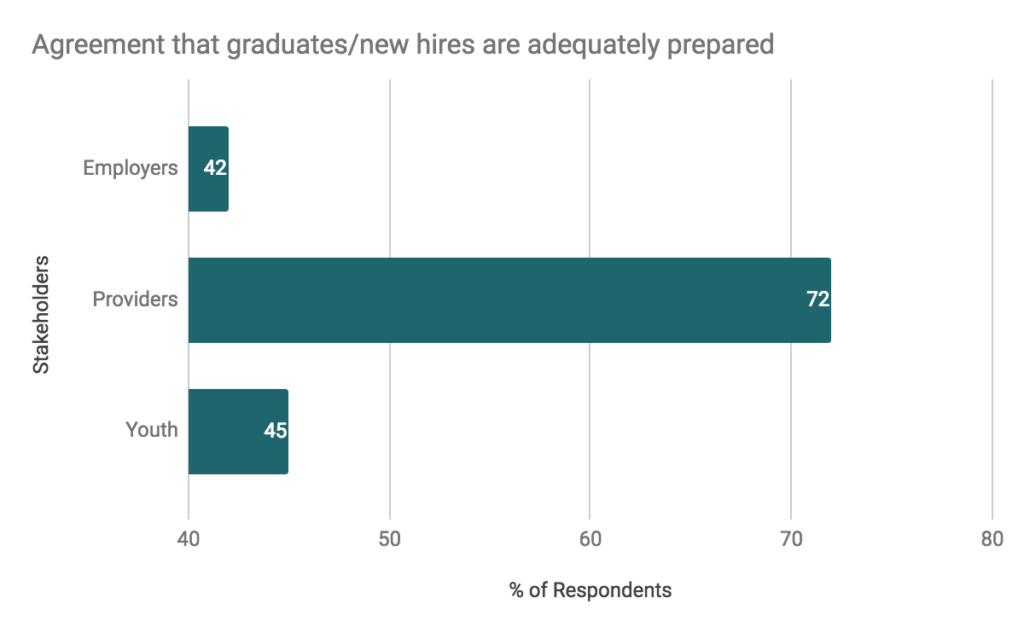
Source: McKinsey On Society36
The disconnect between Education providers and modern workplace requirements conveys the shortcomings of Higher Education. And a lot of it has to do with misdirected incentives.
Higher Education prioritise ‘credentialing’ over skill acquisition. Their incentives are skewed towards ‘bums on seats’ over teaching relevant skills and achieving learning outcomes. As such, Higher Education has increasingly become a ‘tick the box’ exercise for students, particularly in developed countries. This is apparent through the skyrocketing University fee growth across almost all advanced economies. For instance, US College fees for a four year course have risen almost 20 times since 1971.37
The message here is as clear as it is concerning: it doesn’t matter what you learn, so long as you’re here.
But it does matter. It matters a great deal.
WHAT NEEDS TO BE DONE?
There are three key areas that we see as important levers for preparing people for a future with more intelligent machines.
- Education – Adapt school and tertiary education systems to help prepare students for the changing workplace demands.
At a school-level, this means placing a greater emphasis on developing STEM skills, creativity, and critical thinking amongst students. These are the foundational skills that help prepare people for the demands of high-skilled labour. Schools should and will use more technology to achieve learning outcomes. This will help teachers to deliver personalised learning to help enhance students’ strengths and target their weakness for further development.
As teaching quality has the greatest in-school impact on student outcomes,38 equipping our educators with these technical and abstract skills is critical. So, it’s important to adapt Initial Teacher Preparation to best prepare educators with the knowledge and pedagogies to foster these skills in our students.
At a higher-education level, there must be a reorientation towards skill acquisition in priority skill areas. Tertiary providers would do well to partner more readily with industry to inform their curriculum and add practical insight into their content. No longer are universities preparing their students for careers in academia. They’ve become the gateway to professional industry, so they should focus on industry preparation.
Students undergoing any tertiary education should be able to point to a demonstrable set of relevant and applicable skills to future employers. The internet and digital platforms are making skill development and demonstration more accessible than ever before. The opportunities to build scalable training programs for developing countries is immense, as more people come online.
The problem is that tertiary providers aren’t incentivised to do so. They’re attracting exorbitant fees because society places irrational value on credentials. Perhaps it will be necessary to adjust these incentives to help reorient education systems towards prioritising skills over credentials. Or perhaps it will instigate an influx of private training providers to fill this void.
- Policy – Rethink transition support for affected workers and create favourable environments for entrepreneurs to create digitally enabled jobs.
Transition support is more than just Universal Basic Income (UBI). While UBI is a nice ideal, supporters aren’t clear on what constitutes ‘Universal’ or ‘Basic’. ‘Universal’ also presumes international cooperation at a time where nationalism is on the rise.39 However, fiscal and education safety nets should be provided to workers that are displaced from employment.
More immediate, and from my perspective, more important, is how governments and international institutions help support the creation of new jobs, develop necessary skills in their workforces, and successfully match workers to these jobs.
Firstly, it’s important that governments expand the distribution channels of education and training. This will allow more people to acquire the skills that complement and benefit from innovations. Governments should determine how private enterprise can drive skill development. Considering the clear disconnect between traditional education providers and industry, governments would do well to support training at the source of where skill shortages are most acutely felt: private enterprises. This could mean providing incentives for in-work training programs or supporting partnerships with private training providers. In any case, industry should be incentivised to develop their workers and supported to help inform education programs.
Secondly, governments should be proactive in supporting innovation in their cities, states, and countries. Replication is not necessarily the formula here. If governments are trying to copy successes like Silicon Valley, they’re not learning from them. Silicon Valley has been successful precisely because they took a different approach and created a unique ecosystem. Sure, reducing regulatory barriers for innovation and creating tax incentives for Angel investment are important strategies that should be adopted. But the core strategy should be focused on building a unique and supportive ecosystem.
To do this, policymakers should determine the innovation domain that is (or could be) their regional competitive advantage. This could be cryptocurrency, biotech, or even a subcategory like computer vision. Once this has been determined, then the process begins of creating ‘regulatory competitive advantage’, according to that specific domain. This will help attract talent, investment, and potentially spur new domains of innovation in the ecosystem.
- Research – More research in AI needs to occur to ensure that it’s safe and optimal for people.
The magnitude of developments in AI should not be understated. It will change the way we work, interact, and live. Indeed, it already is.
So, you would think that being on the precipice of such significant changes, people would want to have as strong a grasp on the forces stirring these changes. The statistics paint a different a story.
While billions are invested40 in advancing the powers of AI, it’s estimated that fewer than 100 people in the world are researching ways to make AI safe41 and optimal for humanity. Organisations like OpenAI and Professor Nick Bostrom from University of Oxford are the leading the way.
Most of the concerns for AI surround the ‘unintended consequences’. When programmed correctly, intelligent machines do exactly what you tell them, often faster, more accurately, and cheaper than any human. The smarter the system becomes, the harder it is for a person to exercise meaningful oversight. While positive opportunities abound, the negative consequences should not be dismissed.
Take financial credit and Machine Learning systems as an example. Imagine you go to the bank for loan. You’re met by a bank teller (human or otherwise!) and he requests access to your financial information. You feed him the standard details required and it’s entered into the system. The intelligent machine then looks through ALL your available data; where you live, where you work, who’s in your social network, the energy bill you forgot to pay four years ago. All of it. You awkwardly wait with the overdressed bank teller and the system runs its analysis. PING!
‘Credit Denied’.
‘What? How come?’ You cry.
The bank teller shrugs. ‘I dunno. The system said so.’
The problem with this scenario is that it presumes that the intelligent machine considers all the information, explicit and hidden. But what if you come from a poor area, you’re classified in a racial minority group, and you’ve had limited schooling opportunities? You might be an honest, hardworking, and intelligent person, but the system places unjust weightings on your inherited circumstances.
So, if intelligent machines do not account for the social biases and legacy injustices that weigh on our societies today, then we’re at risk of further perpetuating them tomorrow.
We still haven’t developed adequate solutions to a lot of social biases without machines. So blindly extending authority to intelligent machines to make these abstract decisions could be problematic.
This is not an argument to reduce progress in AI. It’s an argument to dramatically increase research in AI.
PROGRESS
While we face very real challenges with the development of intelligent machines, the application of these technologies are still our best hope.
Let me be clear, slowing technological progress in the name of ‘saving jobs’ will punish consumers and stall advancements to quality of life. Applied technologies have cured diseases, reduced famines, and helped lift entire populations out of poverty. But these technological solutions have been successful because of their application, not because of their technological capabilities.
This is an important distinction because it shows that technologies are never deterministic. The utopian and dystopian arguments both assume an inevitable worldview. A determinism that the arc of technological progress bends on its own.
But this reasoning is just lazy. Technology has never been deterministic. Positive outcomes depend on the applied efforts and cooperation of smart people. Entropy is not on our side.
The point is not that technology is harmful; the point is that the progress of technology does not always align neatly to the march of humanity.
So, the progress of humanity is neither guaranteed nor hopeless. Instead, it’s up to us.
- ‘Intelligent Machines’ or ‘Artificial Intelligence’ refers to a non-organic autonomous entities that are able to sense and act upon an environment to achieve specific goals. Intelligent agents may also learn or use knowledge to achieve these goals, which are governed by algorithms that are made by people.
- Pew Research Center (2016), The State of American Jobs: The changing demand for job skills and preparation.
- ‘Low and medium-skilled labour’ refers to routine and rules-based physical and cognitive tasks. Furman, Jason (2016), Is This Time Different? The Opportunities and Challenges of Artificial Intelligence, Council of Economic Advisers to the White House, New York University, pg. 5-6.
- ‘Global South refers to developing countries, which are located primarily in the Southern Hemisphere. United Nations South-South Cooperation (2007).
- McKinsey Global Institute (2016), Poorer than their parents? Flat or Falling Incomes in Advanced Economies.
- Burning Glass Technologies (2016), Beyond Point and Click: The expanding demand for coding skills pg. 3.
- Ernst & Young (2016), Digital Australia: State of the Nation 2015-16 pg. 13.
- Artificial Intelligence is the broad discipline of non-organic intelligent technologies, which includes subset disciplines such as Machine Learning, Natural Language Processing, and Computer Vision.
- Chen, Frank (2016), AI, Deep Learning, and Machine Learning: A Primer [Video], Andreessen Horowitz.
- The Economist (2016) After Moore’s Law: Technology Quarterly June Quarterly Edition.
- Purdy, Mark; & Daugherty, Paul (2016) Why Artificial Intelligence is the Future of Growth Accenture publications pg. 11.
- CB Insights (2016) Artificial Intelligence Explodes: New Deal Activity Record for AI Startups [Blog]
- Gallman, Robert E.; & Weiss, Thomas J. (1969) “The Service Industries in the Nineteenth Century.” In Production and Productivity in the Service Industries, ed. Victor R. Fuchs, 287-352. New York: Columbia University Press.
- 1950–2010: Bureau of Economic Analysis, National Income and Product Accounts.
- Johnston, Lewis (2012) History lessons: Understanding the decline in manufacturing [Blog], MinnPost.
- McKinsey Global Institute (2017) Technology, Jobs, and the Future of Work.
- Deloitte (2015) Technology and People: The great job-creating machine.
- World Economic Forum (2016) The Future of Jobs Report.
- Harari, Yuval N. (2016) Homo Deus: A Brief History of Tomorrow Chapter 9: ‘The Great Decoupling’.
- Pew Research Center (2016), The State of American Jobs: The changing demand for job skills and preparation.
- Ibid
- Ibid
- Ibid
- Autor, David (2014) Skills, education, and the rise of earnings inequality among the ‘other 99 percent, Science, Volume 344, Issue 6186, May 2014. See also: McKinsey Global Institute (2016), Poorer than their parents? Flat or Falling Incomes in Advanced Economies.
- Executive Office of the President (2016), Artificial intelligence, automation, and the economy.
- McKinsey Global Institute (2017) Technology, Jobs, and the Future of Work.
- McKinsey Global Institute (2017) A Future that Works: Automation, Employment, and Productivity, Executive Summary pg. 5.
- Furman, Jason (2016), Is This Time Different? The Opportunities and Challenges of Artificial Intelligence, Council of Economic Advisers to the White House, New York University, pg. 4-5.
- Ibid
- McKinsey Global Institute (2016), Poorer than their parents? Flat or Falling Incomes in Advanced Economies.
- Saez, Emmanuel (2015) Striking it Richer: The Evolution of Top Incomes in the United States.
- World Bank Group (2016) Digital Dividends pg. 23.
- Santos, Indhira (2016) Labor market polarization in developing countries: challenges ahead [Blog], World Bank Group.
- Furman, Jason (2016), Is This Time Different? The Opportunities and Challenges of Artificial Intelligence, Council of Economic Advisers to the White House, New York University, pg. 6.
- McKinsey On Society (2013) Education to Employment: Designing a System that Works, pg. 18-21.
- McKinsey On Society (2013) Education to Employment: Designing a System that Works, pg. 18-21.
- The College Board (2017) Tuition and Fees and Room and Board over Time.
- Hattie, John (2013) Teachers Make a Difference. What is the Research Evidence? ACER Research Conference.
- Onder, Harun (2016) The age factor and rising nationalism, Brookings Institution.
- “Spending on AI technologies by companies is expected to grow to $47 billion in 2020 from a projected $8 billion in 2016, according to IDC.” Norton, Steven (2017) Artificial Intelligence Looms Larger in the Corporate World, The Wall Street Journal. Dow Jones & Company.
- Farquhar, Seb (2017) Changes in funding in the AI safety field. The estimate of ‘under 100’ is based on an informal count of people doing directly relevant work at the organisations in this article, which is significantly below 100. This was cross-checked by estimating the cost per full time staff member: the forecast spending of $9m in 2017 would not be enough to sustain more than 100 staff members given the high cost of hiring machine learning researchers. Note that this figure could be inaccurate if there is a large and non-public AI safety project.

